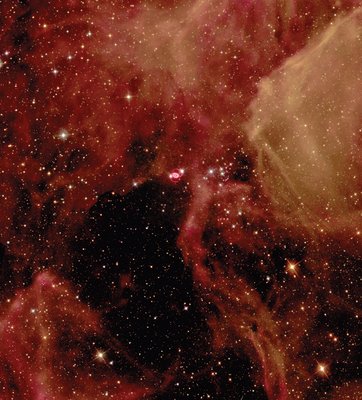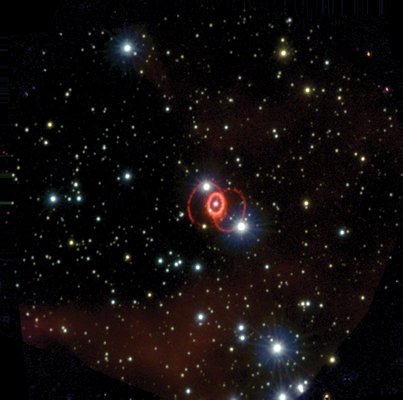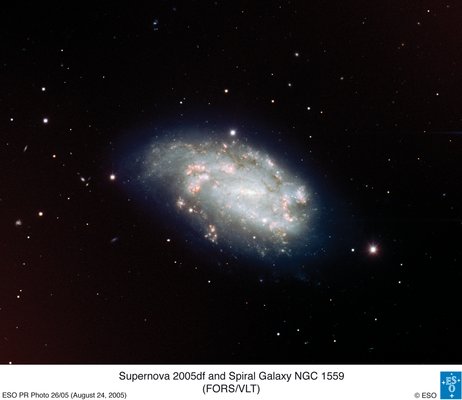
by Cassandra Willyard Thursday, January 5, 2012

Glittering stars and wisps of gas create a breathtaking backdrop for a massive star's self-destruction, called a supernova. NASA, The Hubble Heritage Team, STScI, AURA

Three glowing gas rings around supernova 1987A. P. Challis

Robert Evans has spotted 42 supernovae, more than any other person. The bright star above the spiral galaxy is supernova 2005df, Evans' 40th supernova discovery. European Southern Observatory
Stars, just like people, have finite life spans. Some die quietly. Others go out in a blaze of glory, as supernovae. These brilliant explosions are sometimes visible from Earth, but most appear as only a faint twinkle.
What makes hunting supernovae so difficult is that they look like any other star — so you have to know whether a pinpoint of light is an old twinkle or a new one. Robert Evans is a master when it comes to picking out new twinkles. Using only a backyard telescope and his own eyes, he has discovered 42 supernovae, more than any other person. But Evans isn’t a trained astronomer working in a high-tech lab. He is a Methodist minister in the Blue Mountains of southeastern Australia. Spotting supernovae “is just a hobby,” he says.
Evans is just one of thousands of ordinary people who scan the skies, track the world’s birds and make countless other observations each year. This volunteer army of “citizen scientists” has been hard at work in fields like astronomy and ornithology for more than a century. And over the past two decades, the movement has gained momentum.
The dividing line between professional scientists and nonscientists was not always as clear as it is today. Centuries ago, “we didn’t have professional scientists because we didn’t really have universities where people could go to get degrees,” says Rick Bonney, director of program development and evaluation at the Cornell Lab of Ornithology in Ithaca, N.Y. “So the work was just done by whoever was most interested.”
But as more universities opened their doors, “the sciences became more and more professionalized,” Bonney says. In response, citizen science was born. In the 1880s, a Cornell professor named Wells Cook convinced people in the United States to keep track of the date migratory birds left an area and the date they returned. Around the same time, lighthouse keepers got involved, counting the number of birds that struck lighthouse windows.
The longest-running ornithological citizen science project is the Audubon Society´s Christmas Bird Count. Since 1900, people all over the Americas have gathered at Christmastime to count birds. “The Christmas Bird Count is essentially the great granddaddy of citizen science projects,” says Geoff LeBaron, who directs the project. The first count consisted of 27 observers in 25 locations; last Christmas, more than 50,000 people participated. “I think ornithology has been the field to which amateurs have made the greatest contributions,” Bonney says. “Everybody loves birds.”
Over the last two decades, the Cornell Lab of Ornithology has become a clearinghouse for citizen science, thanks in large part to Bonney, who coined the term in the 1990s. Today, the lab not only hosts several citizen science projects, it also operates a Web site called Citizen Science Central, home to an array of information on the topic.
Citizen science works best when scientists need a large network of observers or a large volume of data. That’s why fields like ornithology, astronomy, botany and meteorology have a long tradition of embracing citizen scientists and their work.
Since 2000, the Sloan Digital Sky Survey has been capturing detailed images of the night sky that contain hundreds of thousands of galaxies. Computer programs can identify where the galaxies are, but they can’t say whether the galaxies are spiral or elliptical. “Shape recognition is something that people are much better at than computers,” says Jordan Raddick, a science educator in the Department of Physics and Astronomy at Johns Hopkins University in Baltimore, Md.
With so many galaxies, however, the task is daunting, as Kevin Schawinski, an astronomer at Yale University in New Haven, Conn., knows. A couple of years ago, as a graduate student at Oxford University in England, he needed to classify 50,000 galaxies in a week. “I was griping to people in the pub about looking at images of galaxies all day long,” he says. “And I thought, ‘Why don’t we put them on the Internet?’”
In 2007, Galaxy Zoo was born. The Web site gives the public a chance to sift through the images and classify galaxies according to their shape. Galaxy Zoo contains about a million galaxies, and Schawinski thought it might take a few years to get them all classified. Instead it took just weeks, thanks to the hard work of tens of thousands of volunteers.
Some scientists have been slow to accept the validity of data collected by the less-highly trained masses. Whether a supernova is actually a supernova is easily verified. But validating other observations is more difficult. So in Galaxy Zoo the participants also serve as fact checkers. “We’re tapping into the wisdom of crowds,” Schawinski says. Dozens of people have classified each galaxy. If 68 out of 70 think a particular galaxy is elliptical, he says, we can be pretty sure the galaxy actually is elliptical. But just to be sure, Schawinski and his colleagues have also compared the 50,000 galaxies that he originally classified with the answers generated by Galaxy Zoo. Overall, the agreement was very good. In fact, four papers based on the Galaxy Zoo data have already been accepted for publication.
The original Galaxy Zoo was so successful that, on Feb. 17, Schawinski and his colleagues launched Galaxy Zoo 2. This time they’re asking the public to describe a galaxy’s distinctive or unusual features — for example, whether it has a bulge in the middle or a ring around it. “Citizen science is definitely a field that’s taking off now,” Raddick says. “I think that there has been a move toward more active involvement.”
That involvement has also helped Gregory Laughlin, an astronomer at the University of California at Santa Cruz who studies extrasolar planets. He organizes citizen scientists to monitor stars for planetary transits — when extrasolar planets pass in front of their stars — which helps astronomers measure a planet’s mass and size.
These events can happen at any time, but they are extremely rare — and they can only be viewed on a cloudless night. Still, the network of amateur astronomers has already discovered one transit. It’s “a million dollar discovery,” Laughlin says. But the scientific community got it for free, thanks to the “highly committed” amateurs with “great observer skills,” he says.
According to Laughlin, the boom in citizen science that began a decade ago has been thanks in large part to advances in technology and the advent of the Internet. The Internet allows citizens an easy way to input their data and scientists an easy way to access the data. What’s more, it allows people all over the world to participate in experiments such as SETI — the Search for Extraterrestrial Intelligence.
SETI uses radio telescopes to scan the skies for narrow bandwidth radio signals. Such signals don’t occur naturally, so finding one would suggest extraterrestrial intelligence. But this endeavor takes an enormous amount of computing power. In the mid-1990s, computer scientist David Gedye came up with a novel idea: Use the Internet to link people’s personal computers together. Instead of sitting idle, these computers could help analyze small chunks of radio telescope data. SETI@home launched in 1999, and it was wildly successful, paving the way for other projects.
More recently, seismologists began using home computers to track earthquakes. Newer Mac laptops contain accelerometers, devices that can sense if a laptop takes a tumble. A widget called “SeisMac” takes data from the computer’s accelerometer and generates a seismograph of the computer’s movement. Elizabeth Cochran, a seismologist at the University of California at Riverside, says she discovered this widget on her laptop and thought, “it would be great to actually network these [computers] and use the data for recording earthquakes.”
Out of Cochran’s idea came the Quake-Catcher Network, which began last year. To participate, all a laptop owner has to do is download software onto his or her accelerometer-equipped computer. The computer does the rest, sending seismic information back to the servers at Stanford University via the Internet. Cochran and her colleagues have even developed accelerometers that plug into a USB port, so people with desktop computers can join.
The United States already has a seismic network, but more data are always useful. Once the network is dense enough, Cochran says, she and her colleagues can use the data to generate early warnings. Of course, they will have to find a way to weed out false alarms — dogs knocking computers to the floor, for instance. But the denser the network, the easier that will be, she says.
Citizen science has even worked its way into medicine. Long chains of amino acids called proteins come in hundreds of thousands of varieties, and their function depends largely on their shape and how they fold. But with so many proteins and so many possible configurations, identifying these shapes has been a challenge. So scientists are turning to the public for help: Researchers at the University of Washington in Seattle have developed a computer game called Foldit. After a brief tutorial, participants can twist and turn long chains of amino acids, forming bonds and hunting for stable configurations.
Such projects rely heavily on technology, but also demonstrate — as when hunting supernovae — that technology can never replace human insight. Even newer telescopes and updated software haven’t replaced Evans’ keen eye. His most recent supernova discovery was just last year.
Increasing competition from other citizen scientists, however, is hindering his endeavors. “Back when I began, few people were interested,” he says. That competition may not be good for Evans, but it is good for the field of astronomy. Every new discovery brings scientists closer to a new understanding of how the universe works.
© 2008-2021. All rights reserved. Any copying, redistribution or retransmission of any of the contents of this service without the expressed written permission of the American Geosciences Institute is expressly prohibited. Click here for all copyright requests.